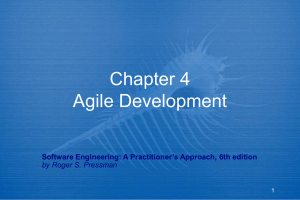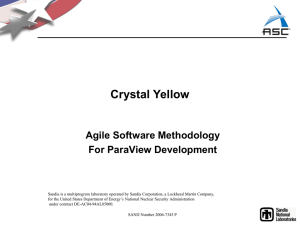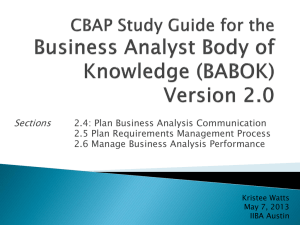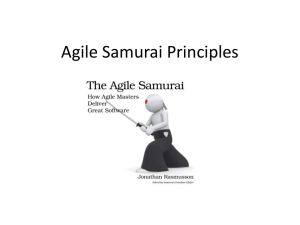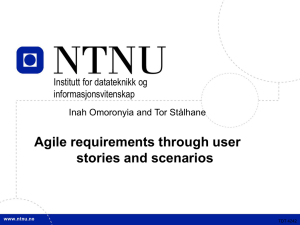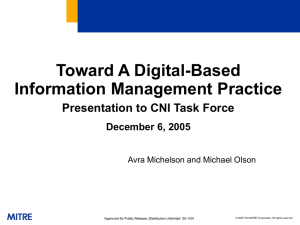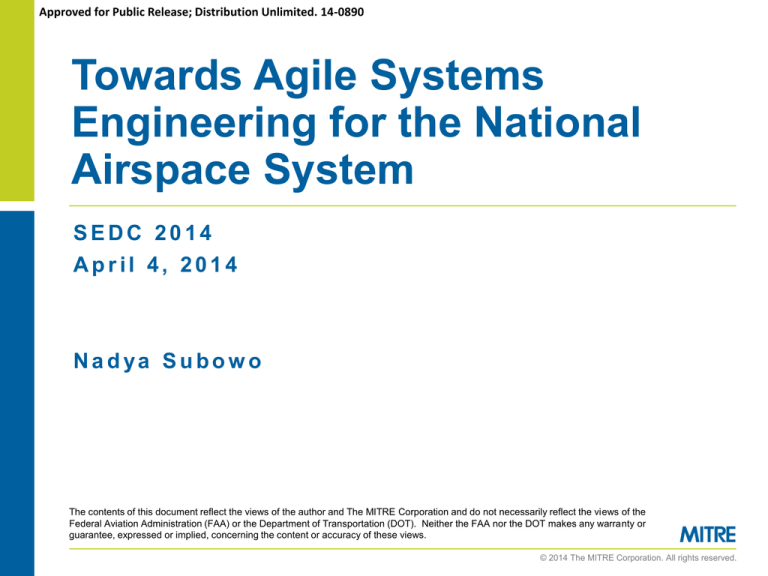
Approved for Public Release; Distribution Unlimited. 14-0890
Towards Agile Systems
Engineering for the National
Airspace System
SEDC 2014
April 4, 2014
Nadya Subow o
The contents of this document reflect the views of the author and The MITRE Corporation and do not necessarily reflect the views of the
Federal Aviation Administration (FAA) or the Department of Transportation (DOT). Neither the FAA nor the DOT makes any warranty or
guarantee, expressed or implied, concerning the content or accuracy of these views.
© 2014 The MITRE Corporation. All rights reserved.
|2|
Outline
Why do we need Agile?
Background
– Next Generation Air Transportation Vision
– Acquisition Management System
Motivation and Scope
Agile Systems Engineering Framework
Agile System Design Framework
Stakeholder Analysis and Impact
Conclusion
Next Steps
© 2014 The MITRE Corporation. All rights reserved.
|3|
Why Do We Need Agile?
Information Technology is a large part of today’s enterprise
infrastructure
Defense Science Board Task Force [1] found that large
information systems take about 91 months to field from
conceptual design to deployment
– Conventional acquisition process does not accommodate systems
that require any hardware/software updates and changes in the
operational requirements
Statutory restrictions have risen due to lack of confidence in the
execution of such program, resulting in increased program
scrutiny and budgetary actions (e.g. funding cuts)
© 2014 The MITRE Corporation. All rights reserved.
|4|
Federal Aviation Administration Vision
© 2014 The MITRE Corporation. All rights reserved.
http://www.jpdo.gov/library/20090521AllHands/20090521_Enterprise_Architecture_Prese
ntation_Jay_Merkle_v2.pdf
|5|
Acquisition Management Process
Where does Systems
Engineering fit in?
© 2014 The MITRE Corporation. All rights reserved.
Federal Aviation Administration. (2006). National Airspace System System Engineering Manual v3.1.
|6|
Motivation & Scope
FAA Lifecycle Management Process Flowchart – Systems Engineering
Concept &
Requirements
Definition
Investment
Analysis
Support concept
and
Requirements
Defintiion
Support
Initial
Investment
Analysis
Support Final
Investment
Analysis
Solution Implementation
Define
System
Architectural
Design
Analyze System
Requirements
Develop System
Architectural
Design
Develop
System
Detailed
Design
Develop and
Test Software
Code
Integrate
Software and
Conduct Design
Qualification Tests
The Federal Aviation Administration (FAA) utilizes traditional
waterfall approach during Solution Implementation
How can the FAA leverage emerging agile practices to deliver
usable NextGen operational capabilities to the aviation community?
© 2014 The MITRE Corporation. All rights reserved.
|7|
Agile Systems Engineering Framework
Adopt agile principles
Solution
Implementation of the
AMS process
A single release is
comprised of several
iterations, adapting to
any technical
changes and creating
a usable system for
the end user
Agile Iteration #1
Concept Definition
Requirements Analysis
System Functional Design
Implementation
Verification
Use in design of nonsafety-critical
systems
© 2014 The MITRE Corporation. All rights reserved.
Deployment
|8|
Integrated Technical Planning
Process that encapsulates the upfront program planning work,
defining the program’s goals and the goals for each iteration
and associated release
Agile Process
– Macro vs. Micro view
– Iteration address high priority and high risk operational features
– Release represents a fully integrated and usable capability
– Continuous user feedback from stakeholders
Evidence Based Framework
The Agile Manifesto states that the “…highest priority of a
program is to satisfy the customer through early and continuous
delivery…” [2]
Iteration
#n
Integrated
Technical
Planning
Concept
Development
© 2014 The MITRE Corporation. All rights reserved.
Requirements
Analysis
Functional
Design
Implementation
Verification
Deployment
|9|
Concept Development
Define the mission needs and capture the primary operational
functions and requirements
Agile Processes
– Establish enterprise understanding of the mission need and the
program’s architecture and objectives to ensure alignment
Defer any detailed design decisions until sufficient information is
available by fostering a collaborative design environment
– Open architecture enables rapid responses and asynchronous
upgrades
Iteration
#n
Integrated
Technical
Planning
Concept
Development
© 2014 The MITRE Corporation. All rights reserved.
Requirements
Analysis
Functional
Design
Implementation
Verification
Deployment
| 10 |
Requirements Analysis
Output a set of known system functions, system requirements,
and measures of performance (acceptance criteria) based on
mission need and additional technical needs from Specialty
Engineering
Agile Process
– User stories to define the operational needs and system
requirements
– Backlog of user stories
– Prioritization of user stories based on risk, need, and/or complexity
User stories for non-functional requirements should be considered as
high priority due to its complexity and may require multiple iterations
The Agile Manifesto stresses the importance of welcoming
requirements changes, even if it is late in the development [2]
Iteration
#n
Integrated
Technical
Planning
Concept
Development
© 2014 The MITRE Corporation. All rights reserved.
Requirements
Analysis
Functional
Design
Implementation
Verification
Deployment
| 11 |
Functional Design
Define an architectural solution that addresses the stakeholder’s
needs and the operational
Agile Process
– The first iteration should define the enterprise level concept and
architecture
– Iterations to refine the enterprise physical architecture
– All internal and external interactions captured as interface
requirements in the requirement’s Backlog for future iterations
Iteration
#n
Integrated
Technical
Planning
Concept
Development
© 2014 The MITRE Corporation. All rights reserved.
Requirements
Analysis
Functional
Design
Implementation
Verification
Deployment
| 12 |
Agile System Design Framework
System design is based on fulfilling an operational need
– What happens when the system becomes too large and costly for any
minor requirements change or technical upgrades?
Desirable to have system components that can be rapidly modified
without repeating the entire system design process
Agile System Design enables rapid adaptation change from one
operating condition to another after initial deployment
– Use in small technical, non-safety-critical systems
– Benefits come from ability to hedge against an uncertain future
– Balance between design flexibility and life cycle cost, including
investment costs and cost for switching operations
© 2014 The MITRE Corporation. All rights reserved.
| 13 |
NextGen Stakeholders
A challenge in systems engineering is balancing disparate
stakeholder needs
Who may present a
Challenge for adopting
agile?
© 2014 The MITRE Corporation. All rights reserved.
| 14 |
POET Analysis and Impact
Political
Many stakeholders including:
Development Contractors
Joint Resource Council (JRC)
Bargaining Units
FAA Organizational Structure
Oversight Committees (GAO, IG)
Congress
Economic
DOT Budget and FAA Appropriation
Investment and maintenance costs
Program Technical Staffing
Operational
Procedures, rulemaking, etc.
Aircraft Standards – Certification and
Equipage Mandates – standards
implementation
Air Carriers & General Aviation
Airports/Airport Authority
Acquisition Management System and
Systems Engineering Process
Technical
Information Systems Security Managers
Safety systems categorization
Technology availability and maturity
Resources
© 2014 The MITRE Corporation. All rights reserved.
*Legend: Red represents strong program influence
| 15 |
How Can Agile be Beneficial?
Technical availability and maturity may be mitigated by an agile
systems engineering or agile system design
– Agile system design - smaller technical, non-safety critical systems
– Agile systems engineering - joint effort for non-safety critical
system/service design and implementation
The FAA can increase USER confidence by incorporating them
early and often into the design and requirements process
Agile allows the FAA to focus on building and delivering
incremental value to the end users in a rapid manner
– Planning for a release incorporates program risks, operational
priorities, cost and schedule constraints
© 2014 The MITRE Corporation. All rights reserved.
| 16 |
Next Steps
Validate the Agile Systems Engineering and Agile System
Design frameworks through a use case study with non-safetycritical NextGen programs
Identify quantifiable and qualitative metrics that show the
benefits of an agile engineering approach
© 2014 The MITRE Corporation. All rights reserved.
| 17 |
Questions?
Nadya Subowo
nsubowo@mitre.org
© 2014 The MITRE Corporation. All rights reserved.
| 18 |
References
[1] Force, Defense Science Board Task. (2009). Department of
Defense Policies and Procedures for the Acquisition of Information
Technology (T. Office of the Under Secretary of Defense For
Acquisition, and Logistics, Trans.) (pp. 109). Washington, D.C.
20301-3140.
[2] “Agile Manifesto.” Manifesto for Agile Software Development.
http://www.agilemanifesto.org/
© 2014 The MITRE Corporation. All rights reserved.
| 19 |
Backup
© 2014 The MITRE Corporation. All rights reserved.
| 20 |
Agile vs. Waterfall
The following definitions characterize agile as the following:
– Agile is an effective response to an opportunity and problem within the
construct of the mission, where effective response is defined as timely,
affordable, predictable (quality), and comprehensive [3]
– Agility applies memory and history to adjust to new environments, react and
adapt, take advantage of unexpected opportunities, and update the
experience base for the future [4]
– A shift from plan-driven to value-driven software development
© 2014 The MITRE Corporation. All rights reserved.






